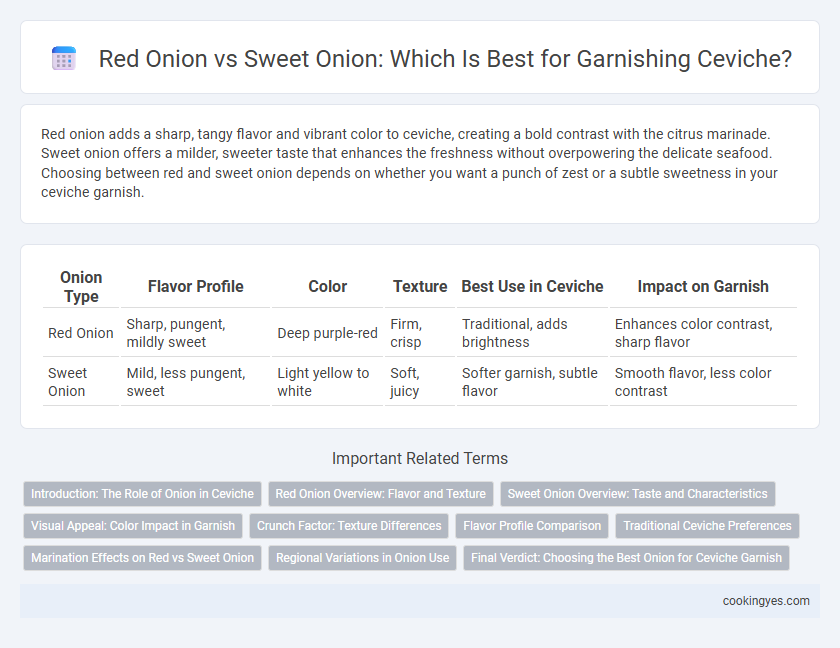Red onion adds a sharp, tangy flavor and vibrant color to ceviche, creating a bold contrast with the citrus marinade. Sweet onion offers a milder, sweeter taste that enhances the freshness without overpowering the delicate seafood. Choosing between red and sweet onion depends on whether you want a punch of zest or a subtle sweetness in your ceviche garnish.
Table of Comparison
| Onion Type | Flavor Profile | Color | Texture | Best Use in Ceviche | Impact on Garnish |
|---|---|---|---|---|---|
| Red Onion | Sharp, pungent, mildly sweet | Deep purple-red | Firm, crisp | Traditional, adds brightness | Enhances color contrast, sharp flavor |
| Sweet Onion | Mild, less pungent, sweet | Light yellow to white | Soft, juicy | Softer garnish, subtle flavor | Smooth flavor, less color contrast |
Introduction: The Role of Onion in Ceviche
Onions play a crucial role in ceviche by adding sharpness and balancing the acidity of the citrus marinade. Red onions are preferred for their vibrant color and slightly pungent flavor that contrasts well with the fish, while sweet onions offer a milder taste and a subtle sweetness that enhances the dish's freshness. Choosing the right onion influences the overall texture and flavor profile, making it essential for an authentic ceviche experience.
Red Onion Overview: Flavor and Texture
Red onions bring a sharp, pungent flavor and a crisp texture that contrasts well with the citrusy freshness of ceviche. Their deep purple hue adds vibrant color, enhancing visual appeal alongside seafood ingredients. The slight bite of red onion helps balance the acidity and complements the tangy marinade typically used in ceviche recipes.
Sweet Onion Overview: Taste and Characteristics
Sweet onions bring a mild, delicate flavor and a crisp texture to ceviche, enhancing the dish without overpowering the fresh citrus and seafood notes. Their lower sulfur content compared to red onions results in less pungency and a subtle sweetness that balances the acidity of lime or lemon juice. Using sweet onions as a garnish creates a refreshing contrast, making each bite smoother and more harmonious in taste.
Visual Appeal: Color Impact in Garnish
Red onions provide a vibrant magenta hue that enhances the visual impact of ceviche with striking color contrast against the white fish and citrus elements. Sweet onions offer a milder, pearly white appearance that lends a subtle, elegant look but lacks the bold pop of red onions. Choosing red onions as a garnish intensifies the dish's appeal, making it more visually dynamic and appetizing for presentation.
Crunch Factor: Texture Differences
Red onions offer a crisp, sharp crunch that enhances the texture contrast in ceviche, providing a vibrant bite that balances the tender fish. Sweet onions, while milder and less pungent, have a softer, less crunchy texture, contributing a subtle sweetness but less firmness to the garnish. For a pronounced crunch factor that elevates the ceviche's mouthfeel, red onions are typically preferred over sweet onions.
Flavor Profile Comparison
Red onions offer a sharp, pungent flavor that adds a bold, spicy kick to ceviche, enhancing its citrusy freshness. Sweet onions provide a milder, slightly sugary taste that balances the acidity without overpowering the delicate seafood flavors. Choosing between red and sweet onions depends on the desired intensity and harmony within the ceviche's overall flavor profile.
Traditional Ceviche Preferences
Traditional ceviche recipes primarily use red onion for garnish due to its sharp, tangy flavor and vibrant color, which complements the citrus-marinated fish. Red onion's slightly pungent taste enhances the dish's freshness without overpowering the delicate seafood, maintaining the authentic balance. Sweet onions, being milder and less acidic, are less common in traditional ceviche and may alter the classic flavor profile preferred in coastal Latin American cuisine.
Marination Effects on Red vs Sweet Onion
Red onions hold their sharpness and vibrant color during marination, adding a bold contrast to ceviche without losing crunch, while sweet onions mellow significantly, offering a softer, sweeter bite that balances acidity. The sulfur compounds in red onions intensify slightly, enhancing the overall flavor profile, whereas sweet onions lose pungency, creating a milder garnish. Choosing between red and sweet onions depends on desired texture and flavor impact, with red onions providing a piquant zest and sweet onions contributing subtle sweetness after marinating.
Regional Variations in Onion Use
Red onions are commonly used in Peruvian ceviche, offering a sharp, tangy flavor that complements the citrus marinade. Sweet onions, favored in some Mexican coastal regions, provide a milder, less pungent garnish that balances the acidity of the lime juice. Regional variations highlight how onion choice influences the overall taste profile and authenticity of ceviche preparations.
Final Verdict: Choosing the Best Onion for Ceviche Garnish
Red onion offers a sharp, pungent flavor and vibrant color that enhances ceviche's fresh acidity, making it the preferred choice for bold taste and visual appeal. Sweet onion provides a milder, less tangy complement that suits palates seeking subtle sweetness without overpowering the dish's delicate seafood flavors. For an optimal ceviche garnish, red onion delivers a more authentic and balanced sensory experience, while sweet onion caters to those preferring a gentler onion presence.
Red Onion vs Sweet Onion for Ceviche Garnish Infographic

 cookingyes.com
cookingyes.com